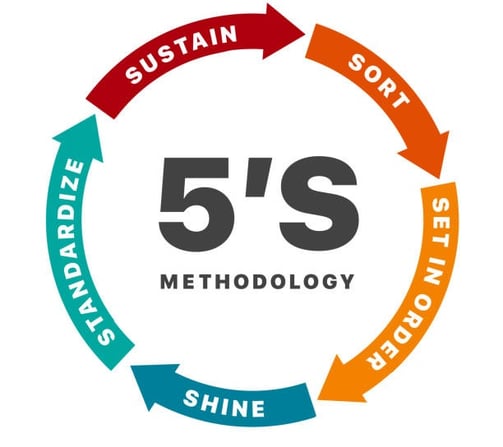Implementing 5S and Kaizen in Small and Medium Manufacturing Industries in India
Learn How to Implement 5S in your Company


Introduction
In today's competitive business environment, small and medium manufacturing industries in India are constantly striving to improve their productivity, efficiency, and overall performance. One effective methodology that can help achieve these goals is the implementation of 5S and Kaizen. In this article, we will explore what 5S and Kaizen are and discuss how they can be implemented in the Indian manufacturing sector.
Understanding 5S
5S is a systematic approach to workplace organization and standardization that originated in Japan. The five pillars of 5S are:
Sort: This involves eliminating unnecessary items from the workplace and organizing essential items.
Set in Order: Once unnecessary items are removed, the next step is to arrange the remaining items in a logical and efficient manner.
Shine: This step focuses on cleaning and maintaining the workplace to ensure a safe and productive environment.
Standardize: Standardizing procedures and processes helps establish consistency and efficiency.
Sustain: Sustaining the improvements made by continuously practicing and reinforcing the 5S principles.
Benefits of Implementing 5S
The implementation of 5S brings several benefits to small and medium manufacturing industries in India:
Improved Efficiency: 5S helps eliminate waste, reduce unnecessary movement, and optimize the layout of the workplace, resulting in improved productivity and efficiency.
Enhanced Safety: A well-organized workplace reduces the risk of accidents and injuries, creating a safer working environment for employees.
Streamlined Operations: 5S helps streamline processes, reduce downtime, and improve overall workflow, leading to smoother operations.
Increased Employee Morale: A clean and organized workplace promotes a positive work culture, boosts employee morale, and fosters a sense of pride in their work.
Improved Quality: By eliminating clutter and standardizing processes, 5S helps identify and address quality issues, leading to improved product quality.
Implementing 5S in Indian Manufacturing SMEs
Implementing 5S in small and medium manufacturing industries in India requires a systematic approach and the involvement of all employees. Here are the steps to follow:
Step 1: Create Awareness
The first step is to create awareness among employees about the benefits of 5S and how it can positively impact their work environment. Conduct training sessions and workshops to educate employees about the principles and methodology of 5S.
Step 2: Sort and Remove
Encourage employees to identify and remove unnecessary items from the workplace. This includes disposing of broken equipment, outdated documents, and unused materials. Categorize essential items and ensure they are properly labeled and stored.
Step 3: Set in Order
Once the unnecessary items are removed, focus on organizing the remaining items in a logical and efficient manner. Assign specific locations for tools, equipment, and materials, and clearly label them. This will help reduce time wasted searching for items and improve overall productivity.
Step 4: Shine and Clean
Regular cleaning and maintenance of the workplace are essential for a safe and productive environment. Encourage employees to take responsibility for cleaning their workstations and provide the necessary tools and resources to support this practice.
Step 5: Standardize and Document
Establish standardized procedures and processes for various tasks. Document these procedures and make them easily accessible to all employees. This will ensure consistency and efficiency in operations.
Step 6: Sustain and Continuously Improve
Implement mechanisms to sustain the improvements made through 5S. This includes regular audits, employee involvement, and continuous improvement initiatives. Encourage employees to provide feedback and suggestions for further enhancements.
Integrating Kaizen with 5S
Kaizen, which means continuous improvement in Japanese, complements the 5S methodology. It focuses on small, incremental improvements in processes and operations. Here's how Kaizen can be integrated with 5S:
Encourage Employee Involvement
Involve employees in the identification of improvement opportunities and encourage them to suggest ideas for small changes that can lead to significant improvements. Recognize and reward employees for their contributions.
Implement Small Changes
Encourage the implementation of small changes on a regular basis. These changes can be as simple as rearranging workstations, improving communication channels, or implementing visual management techniques. Small changes, when implemented consistently, can have a cumulative positive impact on productivity and efficiency.
Measure and Track Progress
Establish key performance indicators (KPIs) to measure the impact of Kaizen initiatives. Regularly track and analyze the data to identify trends and areas for further improvement.
Provide Training and Support
Offer training programs and workshops to educate employees about the Kaizen philosophy and provide them with the necessary tools and techniques to implement continuous improvement initiatives.
Embrace a Culture of Continuous Improvement
Cultivate a work culture that encourages and supports continuous improvement. Foster an environment where employees feel empowered to suggest ideas, experiment with new approaches, and learn from both successes and failures.
The implementation of 5S and Kaizen can significantly benefit small and medium manufacturing industries in India. By organizing the workplace, eliminating waste, and continuously improving processes, these industries can enhance efficiency, productivity, and overall performance. It is crucial to involve employees at all levels and foster a culture of continuous improvement to sustain the gains achieved through these methodologies. With a systematic approach and commitment to change, Indian manufacturing SMEs can thrive in today's competitive market.

